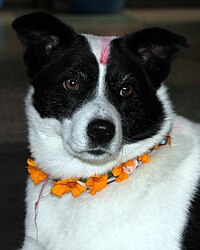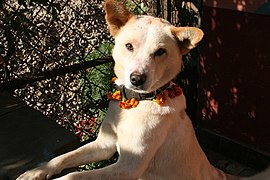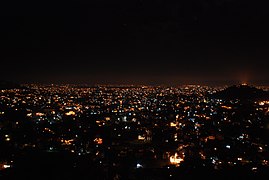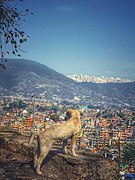ਕੁਕੁਰ ਤਿਹਾਰ
| ਕੁਕੁਰ ਤਿਹਾਰ | |
|---|---|
 ਫੁੱਲਾਂ ਦੇ ਹਾਰਾਂ ਨਾਲ ਸਜਿਆ ਕੁੱਤਾ | |
| ਅਧਿਕਾਰਤ ਨਾਮ | कुकुर तिहार |
| ਵੀ ਕਹਿੰਦੇ ਹਨ | ਕੁੱਤਿਆਂ ਦਾ ਤਿਉਹਾਰ |
| ਕਿਸਮ | ਧਾਰਮਿਕ |
| ਜਸ਼ਨ | ਕੁੱਤਿਆਂ ਦਾ ਸਨਮਾਨ ਕਰਨਾ |
| ਪਾਲਨਾਵਾਂ | ਪ੍ਰਾਰਥਨਾਵਾਂ ਅਤੇ ਧਾਰਮਿਕ ਰਸਮਾਂ |
| ਮਿਤੀ | ਕਾਰਤਿਕਾ ਮਾਸਾ ਕ੍ਰਿਸ਼ਨ ਪੱਖ ਚਤੁਰਦਸ਼ੀ ਤਿਥੀ |
| ਬਾਰੰਬਾਰਤਾ | ਸਾਲਾਨਾ |
ਕੁਕੁਰ ਤਿਹਾਰ ( ਨਰਕ ਚਤੁਰਦਸ਼ੀ, Nepali: कुकुर तिहार ) ਇੱਕ ਸਲਾਨਾ ਹਿੰਦੂ ਤਿਉਹਾਰ ਹੈ ਜੋ ਨੇਪਾਲ ਤੋਂ ਸ਼ੁਰੂ ਹੁੰਦਾ ਹੈ ਜੋ ਤਿਹਾਰ ਦੇ ਤਿਉਹਾਰ ਦੇ ਦੂਜੇ ਦਿਨ (ਅਕਤੂਬਰ ਜਾਂ ਨਵੰਬਰ ਦੇ ਆਸਪਾਸ) ਆਉਂਦਾ ਹੈ। ਇਸ ਦਿਨ ਲੋਕ ਮੌਤ ਦੇ ਦੇਵਤਾ ਯਮ ਨੂੰ ਖੁਸ਼ ਕਰਨ ਲਈ ਕੁੱਤਿਆਂ ਦੀ ਪੂਜਾ ਕਰਦੇ ਹਨ, ਕਿਉਂਕਿ ਉਨ੍ਹਾਂ ਨੂੰ ਉਸ ਦਾ ਦੂਤ ਮੰਨਿਆ ਜਾਂਦਾ ਹੈ। ਕੁੱਤਿਆਂ ਨੂੰ ਤਿਲਕ ਨਾਲ ਸਜਾਇਆ ਜਾਂਦਾ ਹੈ ਅਤੇ ਉਨ੍ਹਾਂ ਦੇ ਗਲਾਂ ਵਿੱਚ ਫੁੱਲਾਂ ਦੇ ਮਾਲਾ ਪਹਿਨਦੇ ਹਨ। ਸ਼ਰਧਾਲੂ ਉਨ੍ਹਾਂ ਨੂੰ ਮੀਟ, ਦੁੱਧ, ਅੰਡੇ ਅਤੇ ਕੁੱਤੇ ਦੇ ਭੋਜਨ ਸਮੇਤ ਵੱਖ-ਵੱਖ ਭੋਜਨ ਪੇਸ਼ ਕਰਦੇ ਹਨ। ਇਸ ਦਿਨ ਜੇਕਰ ਕੋਈ ਵਿਅਕਤੀ ਕੁੱਤੇ ਦਾ ਨਿਰਾਦਰ ਕਰਦਾ ਹੈ ਤਾਂ ਇਸ ਨੂੰ ਪਾਪ ਮੰਨਿਆ ਜਾਂਦਾ ਹੈ।
ਕੁਕੁਰ ਤਿਹਾਰ ਨੂੰ ਨੇਪਾਲੀ ਡਾਇਸਪੋਰਾ ਦੁਆਰਾ ਵੀ ਦੁਨੀਆ ਭਰ ਵਿੱਚ ਮਨਾਇਆ ਜਾਂਦਾ ਹੈ। ਤਿਹਾਰ ਨੇਪਾਲ ਤੋਂ ਸ਼ੁਰੂ ਹੋਇਆ ਇੱਕ ਪੰਜ ਦਿਨਾਂ-ਲੰਬਾ ਹਿੰਦੂ ਤਿਉਹਾਰ ਹੈ; ਦਸ਼ੈਨ ਤੋਂ ਬਾਅਦ ਇਹ ਦੇਸ਼ ਦਾ ਦੂਜਾ ਸਭ ਤੋਂ ਵੱਡਾ ਤਿਉਹਾਰ ਹੈ।[2][3][4]ਕੁਕੁਰ ਤਿਹਾਰ ਤਿਹਾਰ ਦੇ ਦੂਜੇ ਦਿਨ ਮਨਾਇਆ ਜਾਂਦਾ ਹੈ।[3][5]ਤਿਹਾਰ ਦੇ ਤਿਉਹਾਰ ਦੌਰਾਨ, ਗਾਵਾਂ ਅਤੇ ਕਾਂ ਸਮੇਤ ਕਈ ਜਾਨਵਰਾਂ ਦੀ ਵੀ ਪੂਜਾ ਕੀਤੀ ਜਾਂਦੀ ਹੈ।[6][7]
ਪ੍ਰਾਚੀਨ ਸੰਸਕ੍ਰਿਤ ਮਹਾਂਕਾਵਿ ਮਹਾਂਭਾਰਤ ਵਿੱਚ, ਪੰਜ ਪਾਂਡਵ ਸਵਰਗ ਨੂੰ ਜਾਂਦੇ ਹੋਏ ਇੱਕ ਕੁੱਤੇ ਦੇ ਨਾਲ ਹਨ।[8]ਪੰਜ ਪਾਂਡਵ ਆਪਣੀ ਪਤਨੀ ਦ੍ਰੋਪਦੀ ਅਤੇ ਭਰਾਵਾਂ ਨਾਲ ਹਿਮਾਲਿਆ ਦੀ ਚੜ੍ਹਾਈ ਕਰਦੇ ਹਨ; ਯੁਧਿਸ਼ਠਿਰ ਅਤੇ ਉਸਦੇ ਕੁੱਤੇ ਨੂੰ ਛੱਡ ਕੇ ਸਾਰੇ ਰਸਤੇ ਵਿੱਚ ਹੀ ਮਰ ਗਏ।[9]ਫਿਰ ਯੁਧਿਸ਼ਠਿਰ ਦੇਵਤਿਆਂ ਦੇ ਰਾਜਾ ਇੰਦਰ ਨੂੰ ਮਿਲਦਾ ਹੈ, ਜੋ ਸਵਰਗ ਵਿੱਚ ਉਸਦਾ ਸੁਆਗਤ ਕਰਦਾ ਹੈ ਪਰ ਉਸਨੂੰ ਕਹਿੰਦਾ ਹੈ ਕਿ ਉਸਨੂੰ ਆਪਣੇ ਕੁੱਤੇ ਨੂੰ ਪਿੱਛੇ ਛੱਡਣਾ ਪਵੇਗਾ।[9][10]ਯੁਧਿਸ਼ਟਰ ਨੇ ਆਪਣੇ ਕੁੱਤੇ ਤੋਂ ਬਿਨਾਂ ਸਵਰਗ ਵਿਚ ਜਾਣ ਤੋਂ ਇਨਕਾਰ ਕਰ ਦਿੱਤਾ ਅਤੇ ਕਿਹਾ ਕਿ ਉਹ ਧਰਤੀ 'ਤੇ ਵਾਪਸ ਚਲਾ ਜਾਵੇਗਾ।[9][11][12]ਕੁੱਤਾ ਗਾਇਬ ਹੋ ਜਾਂਦਾ ਹੈ ਅਤੇ ਉਸਦੀ ਥਾਂ ਮੌਤ ਦੇ ਦੇਵਤਾ ਯਮ ਨੇ ਲੈ ਲਈ ਹੈ; ਇੰਦਰ ਉਸਦੇ ਕੰਮਾਂ ਤੋਂ ਪ੍ਰਭਾਵਿਤ ਹੁੰਦਾ ਹੈ ਅਤੇ ਫਿਰ ਉਸਦੀ ਧਾਰਮਿਕਤਾ ਨੇ ਯੁਧਿਸ਼ਠਿਰ ਲਈ ਸਵਰਗ ਦੇ ਦਰਵਾਜ਼ੇ ਖੋਲ੍ਹ ਦਿੱਤੇ।[9][10]
ਹਿੰਦੂ ਮਿਥਿਹਾਸ ਵਿੱਚ, ਯਮ ਦੇ ਦੋ ਕੁੱਤੇ ਹਨ - ਸ਼ਿਆਮਾ ਅਤੇ ਸ਼ਰਵਰਾ - ਜੋ ਨਰਕ ਦੇ ਦਰਵਾਜ਼ੇ ਦੀ ਰਾਖੀ ਕਰਦੇ ਹਨ।[13]ਨੇਪਾਲੀ ਹਿੰਦੂਆਂ ਦਾ ਮੰਨਣਾ ਹੈ ਕਿ ਕੁੱਤਿਆਂ ਦੀ ਪੂਜਾ ਕਰਨ ਨਾਲ ਉਹ ਮੌਤ ਨੂੰ ਸਕਾਰਾਤਮਕ ਤੌਰ 'ਤੇ ਦੇਖਣਾ ਸ਼ੁਰੂ ਕਰ ਦਿੰਦੇ ਹਨ, ਕਿਉਂਕਿ ਉਨ੍ਹਾਂ ਦੀ ਅੰਤਿਮ ਯਾਤਰਾ ਵਿੱਚ ਇੱਕ ਕੁੱਤਾ ਉਨ੍ਹਾਂ ਦਾ ਪਿੱਛਾ ਕਰਦਾ ਹੈ।[14]ਉਹ ਉਮੀਦ ਕਰਦੇ ਹਨ ਕਿ ਕੁੱਤੇ ਨਰਕ ਵਿੱਚ ਤਸੀਹੇ ਦੇ ਵਿਰੁੱਧ ਉਨ੍ਹਾਂ ਦੀ ਰੱਖਿਆ ਕਰਨਗੇ. [14] ਕੁੱਤਿਆਂ ਨੂੰ ਯਮ ਦਾ ਸਾਥੀ ਮੰਨਿਆ ਜਾਂਦਾ ਹੈ ਅਤੇ ਉਸ ਨੂੰ ਖੁਸ਼ ਕਰਨ ਲਈ ਕੁੱਤਿਆਂ ਦੀ ਪੂਜਾ ਕੀਤੀ ਜਾਂਦੀ ਹੈ।[15][16]
ਏਬੀਸੀ ਸਾਇੰਸ ਦੇ ਅਨੁਸਾਰ, ਕੁੱਤਿਆਂ ਨੂੰ ਸਭ ਤੋਂ ਪਹਿਲਾਂ ਨੇਪਾਲ ਅਤੇ ਮੰਗੋਲੀਆ ਵਿੱਚ ਪਾਲਿਆ ਗਿਆ ਸੀ।[17]
ਜਸ਼ਨ
[ਸੋਧੋ]ਤਿਹਾਰ ਹਰ ਸਾਲ ਅਕਤੂਬਰ ਜਾਂ ਨਵੰਬਰ ਦੇ ਆਸਪਾਸ ਮਨਾਇਆ ਜਾਂਦਾ ਹੈ।[18] ਤਿਉਹਾਰ ਦੇ ਦੌਰਾਨ, ਕੁੱਤਿਆਂ ਦੀ ਪੂਜਾ ਕੀਤੀ ਜਾਂਦੀ ਹੈ, ਇਸ਼ਨਾਨ ਕੀਤਾ ਜਾਂਦਾ ਹੈ ਅਤੇ ਤਿਲਕ ਨਾਲ ਸਜਾਇਆ ਜਾਂਦਾ ਹੈ, ਜੋ ਕਿ ਕੁੰਕੁਮਾ ਜਾਂ ਗੁਲਾਲ ਪਾਊਡਰ ਤੋਂ ਚੌਲਾਂ ਅਤੇ ਦਹੀਂ ਨਾਲ ਬਣਾਇਆ ਜਾਂਦਾ ਹੈ।[19][20]ਉਨ੍ਹਾਂ ਦੇ ਗਲੇ ਦੁਆਲੇ ਫੁੱਲਾਂ ਦੇ ਮਾਲਾ ਵਿਛਾਏ ਜਾਂਦੇ ਹਨ ਅਤੇ ਉਨ੍ਹਾਂ ਨੂੰ ਮੀਟ, ਦੁੱਧ, ਅੰਡੇ ਅਤੇ ਕੁੱਤਿਆਂ ਦੇ ਭੋਜਨ ਸਮੇਤ ਭੋਜਨ ਦੀ ਪੇਸ਼ਕਸ਼ ਕੀਤੀ ਜਾਂਦੀ ਹੈ।[21]ਪੁਲਿਸ ਦੇ ਕੁੱਤਿਆਂ ਅਤੇ ਆਵਾਰਾ ਕੁੱਤਿਆਂ ਨੂੰ ਵੀ ਸਨਮਾਨਿਤ ਕੀਤਾ ਗਿਆ।[22]ਕੁਕੁਰ ਤਿਹਾਰ ਕੁੱਤਿਆਂ ਅਤੇ ਮਨੁੱਖਾਂ ਦੇ ਰਿਸ਼ਤੇ ਨੂੰ ਵੀ ਮਨਾਉਂਦਾ ਹੈ।[23]ਇਸ ਦਿਨ ਜੇਕਰ ਕੋਈ ਵਿਅਕਤੀ ਕੁੱਤੇ ਨਾਲ ਬੇਇੱਜ਼ਤੀ ਕਰਦਾ ਹੈ ਤਾਂ ਇਸ ਨੂੰ ਪਾਪ ਮੰਨਿਆ ਜਾਂਦਾ ਹੈ।[24]
ਗੈਲਰੀ
[ਸੋਧੋ]-
ਫੁੱਲਾਂ ਦੇ ਹਾਰਾਂ ਨਾਲ ਸਜਿਆ ਕੁੱਤਾ
-
ਦੀਪਾਵਾਲੀ ਤੋਂ ਇੱਕ ਦਿਨ ਪਹਿਲਾਂ, ਪੰਜ ਦਿਨਾਂ ਤਿਹਾਰ ਤਿਉਹਾਰ ਦੇ ਦੂਜੇ ਦਿਨ ਕੁਕੁਰ ਤਿਹਾਰ ਮਨਾਇਆ ਜਾਂਦਾ ਹੈ।
-
ਕੁੱਤੇ ਦੇ ਪੈਰ ਅਤੇ ਮੱਥੇ ਨੂੰ ਲਾਲ ਟਿੱਕਾ ਲੱਗਾ ਹੋਇਆ ਹੈ
-
ਇਸ ਦਿਨ ਪਾਲਤੂ ਕੁੱਤਿਆਂ ਦੇ ਨਾਲ-ਨਾਲ ਆਵਾਰਾ ਕੁੱਤਿਆਂ ਦੀ ਵੀ ਪੂਜਾ ਕੀਤੀ ਜਾਂਦੀ ਹੈ।
ਹਵਾਲੇ
[ਸੋਧੋ]- ↑ "२०७८ सालको तिहारपर्व सँग सम्वन्धित दिन तथा साईतहरू". Nepal Panchanga Nirnayak Samitee (in ਨੇਪਾਲੀ). Archived from the original on 1 ਨਵੰਬਰ 2021. Retrieved 1 November 2021.
- ↑ "Market in border area bustling". The Himalayan Times (in ਅੰਗਰੇਜ਼ੀ (ਅਮਰੀਕੀ)). 9 November 2020. Retrieved 10 November 2020.
- ↑ 3.0 3.1 "Nepal festival celebrates 'day of the dogs'" (in ਅੰਗਰੇਜ਼ੀ (ਬਰਤਾਨਵੀ)). BBC. 6 November 2018. Archived from the original on 27 October 2020. Retrieved 27 October 2020.
- ↑ Prasain, Krishana (21 October 2020). "Nepal's biggest festival Dashain fails to lift the market mood, buyers and sellers say". The Kathmandu Post (in English). Archived from the original on 10 November 2020. Retrieved 10 November 2020.
{{cite web}}: CS1 maint: unrecognized language (link) - ↑ Devleesschauwer, Brecht (12 February 2016). "Epidemiology, Impact and Control of Rabies in Nepal: A Systematic Review". PLOS Neglected Tropical Diseases (in ਅੰਗਰੇਜ਼ੀ). 10 (2): e0004461. doi:10.1371/journal.pntd.0004461. ISSN 1935-2735. PMC 4752342. PMID 26871689.
{{cite journal}}: Unknown parameter|displayauthors=ignored (|display-authors=suggested) (help)CS1 maint: unflagged free DOI (link) - ↑ Kelly, Erin (5 October 2015). "In Nepal, Every Dog Has Its Day. Literally". All That's Interesting (in ਅੰਗਰੇਜ਼ੀ (ਅਮਰੀਕੀ)). Archived from the original on 27 October 2020. Retrieved 27 October 2020.
- ↑ Devkota, Mahima (3 November 2021). "Why do we worship crows and dogs?". The Rising Nepal (in ਅੰਗਰੇਜ਼ੀ). Archived from the original on 3 November 2021. Retrieved 21 November 2021.
- ↑ Shahani, Shradha (22 October 2019). "In Nepal, Diwali is a time to worship the dogs". Condé Nast Traveller (in Indian English). Archived from the original on 27 October 2020. Retrieved 27 October 2020.
- ↑ 9.0 9.1 9.2 9.3 Vajpeyi, Ananya (29 June 2019). "Epic lessons for Kali Yuga: Rereading the 'Mahabharata' in our contemporary moment". The Hindu (in Indian English). ISSN 0971-751X. Archived from the original on 27 October 2020. Retrieved 27 October 2020.
- ↑ 10.0 10.1 Singh, Sudeshna (8 April 2020). "Interested in the Mahabharata? Know how the Pandavas died". Times Now (in ਅੰਗਰੇਜ਼ੀ). Archived from the original on 27 October 2020. Retrieved 27 October 2020.
- ↑ Das, Gitanjali (6 September 2020). "Explained: After Modi's push, a look at the several dog breeds native to India". The Indian Express (in ਅੰਗਰੇਜ਼ੀ). Archived from the original on 27 October 2020. Retrieved 27 October 2020.
- ↑ "Day of the Dog: A day before Diwali, Nepal celebrates 'dog puja festival' with fervour – See pics". Times Now (in ਅੰਗਰੇਜ਼ੀ). 7 November 2018. Archived from the original on 27 October 2020. Retrieved 27 October 2020.
- ↑ "Dogs worshipped on Kukur Tihar". The Kathmandu Post (in English). 10 November 2015. Archived from the original on 27 October 2020. Retrieved 27 October 2020.
{{cite web}}: CS1 maint: unrecognized language (link) - ↑ 14.0 14.1 Marak, Queenbala; Chaudhuri, Sarit K. (28 February 2020). The Cultural Heritage of Meghalaya (in ਅੰਗਰੇਜ਼ੀ). Routledge. ISBN 978-1-000-07182-5. Archived from the original on 28 October 2020. Retrieved 28 October 2020.
- ↑ "Nepal festival celebrates 'day of the dogs'" (in ਅੰਗਰੇਜ਼ੀ (ਬਰਤਾਨਵੀ)). BBC. 6 November 2018. Archived from the original on 27 October 2020. Retrieved 27 October 2020.
- ↑ "Kukur Tihar, Laxmi Puja observed; Bhai Tika tomorrow". The Himalayan Times (in ਅੰਗਰੇਜ਼ੀ (ਅਮਰੀਕੀ)). 28 October 2019. Archived from the original on 27 October 2020. Retrieved 27 October 2020.
- ↑ Images, Timothy Allen/Getty (20 October 2015). "Dogs may have been first domesticated in Nepal and Mongolia". ABC News (in Australian English). Australian Broadcasting Corporation. Archived from the original on 27 October 2020. Retrieved 27 October 2020.
- ↑ Dahal, Phanindra (2 October 2020). "Covid: God may punish Nepal for cancelling rites, religious leaders warn" (in ਅੰਗਰੇਜ਼ੀ (ਬਰਤਾਨਵੀ)). BBC. Archived from the original on 28 October 2020. Retrieved 28 October 2020.
- ↑ Marak, Queenbala; Chaudhuri, Sarit K. (28 February 2020). The Cultural Heritage of Meghalaya (in ਅੰਗਰੇਜ਼ੀ). Routledge. ISBN 978-1-000-07182-5. Archived from the original on 28 October 2020. Retrieved 28 October 2020.
- ↑ "Did you know there is a dog puja festival in Nepal on Choti Diwali day?". The Indian Express (in ਅੰਗਰੇਜ਼ੀ). 18 October 2017. Archived from the original on 27 October 2020. Retrieved 27 October 2020.
- ↑ "Nepal festival celebrates 'day of the dogs'" (in ਅੰਗਰੇਜ਼ੀ (ਬਰਤਾਨਵੀ)). BBC. 6 November 2018. Archived from the original on 27 October 2020. Retrieved 27 October 2020.
- ↑ "Dogs in Nepal enjoy treats, affection". Gulf Times. 30 October 2016. Archived from the original on 14 November 2016. Retrieved 27 October 2020.
- ↑ Whitehead, Joanna (8 November 2018). "This Nepalese festival has an entire day devoted to celebrating dogs". The i (in ਅੰਗਰੇਜ਼ੀ). Archived from the original on 27 October 2020. Retrieved 28 October 2020.
- ↑ Mayol, Taylor (20 October 2015). "All Dogs Go to Heaven … in Nepal". OZY. Archived from the original on 27 October 2020. Retrieved 27 October 2020.
- CS1 ਨੇਪਾਲੀ-language sources (ne)
- CS1 ਅੰਗਰੇਜ਼ੀ (ਬਰਤਾਨਵੀ)-language sources (en-gb)
- CS1 errors: unsupported parameter
- CS1 maint: unflagged free DOI
- CS1 ਅੰਗਰੇਜ਼ੀ-language sources (en)
- CS1 Indian English-language sources (en-in)
- CS1 Australian English-language sources (en-au)
- Articles containing Nepali (macrolanguage)-language text
- Infobox holiday with missing field
- ਤਿਉਹਾਰ




